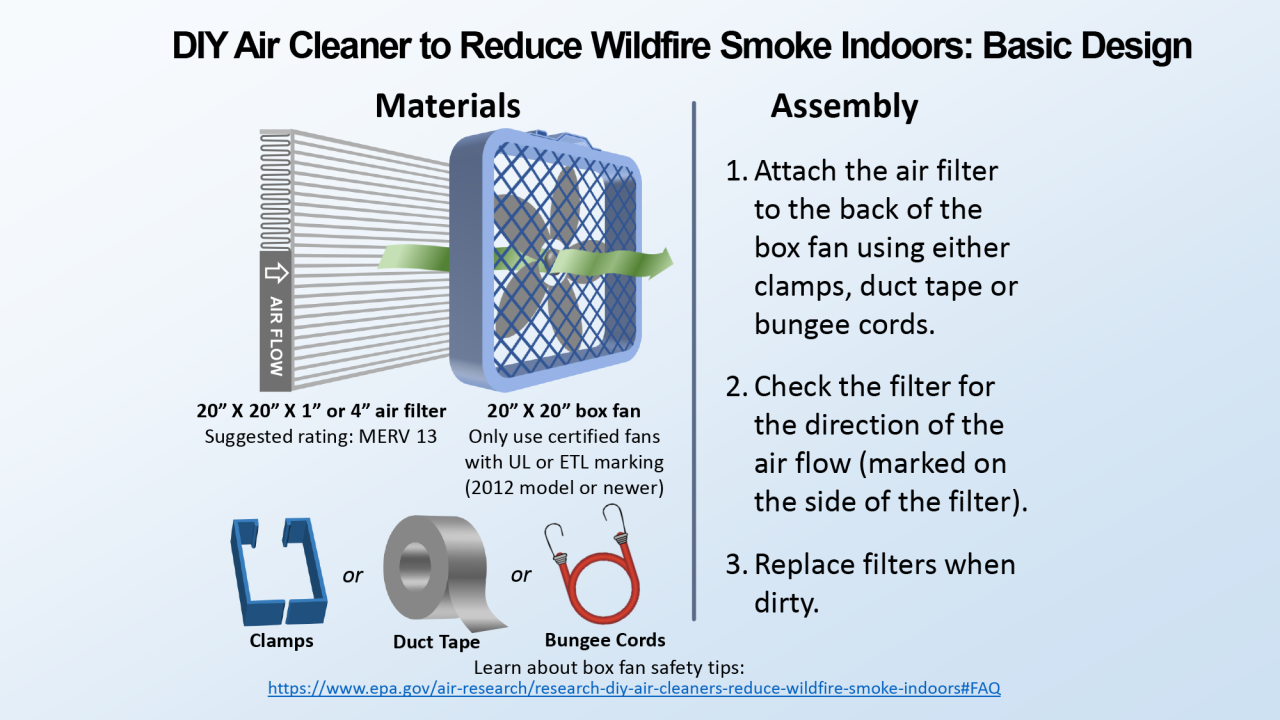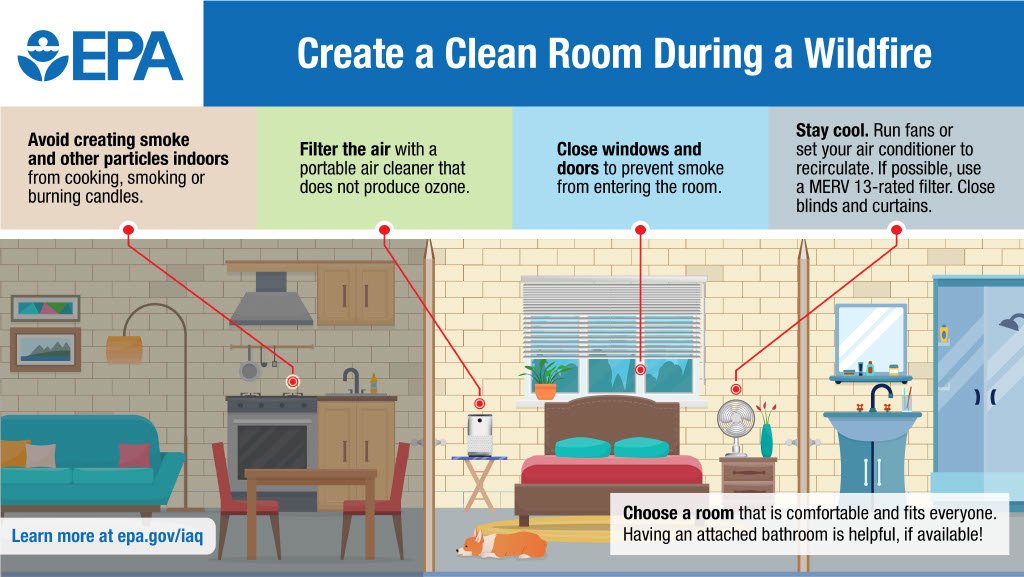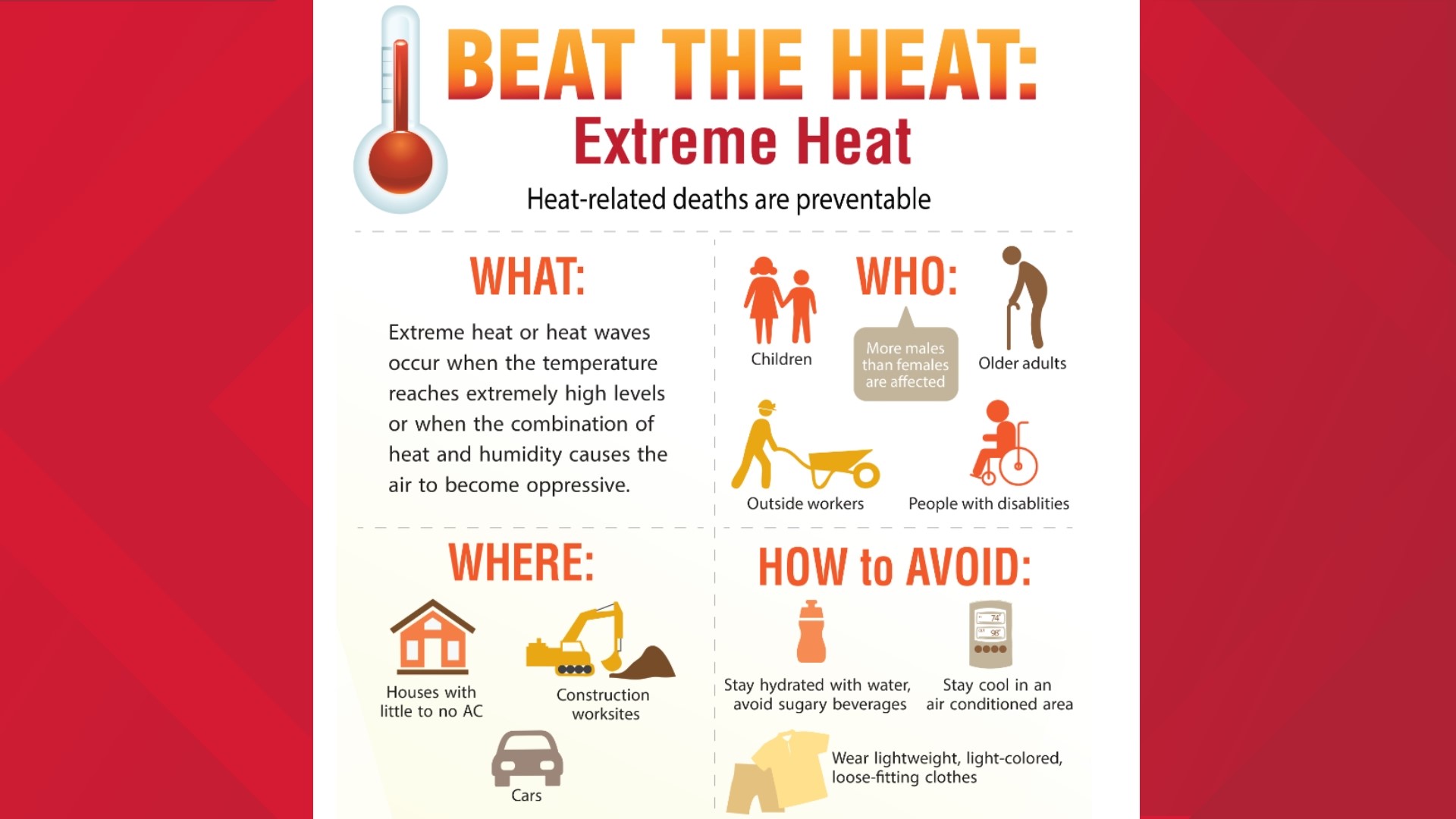
As extreme heat and wildfire smoke events become more common, it’s essential to know how to protect yourself and your household. This guide offers key tips for staying safe and provides links to additional resources to help you prepare in advance. While the advice here is general, individuals with higher health risks should consult their healthcare provider for personalized guidance.
The following are preventative practices that you can implement in your home to keep it cool and free of air pollution. Each practice has a variety of resources that include instructions, research, and contacts for easy implementation. These strategies work best together, so stay open to using all options.
Install an Air Purifier
A portable air cleaner is a device that removes air contaminants from indoor air, often referred to commercially as an “air purifier.” Portable air cleaners are an effective way to remove wildfire smoke from indoor air. It’s important to keep indoor air as clean as possible to prevent negative health effects caused by contaminants. Below are helpful resources that provide more information about different types of air purifiers and can help you choose one that is right for you and your home.
Choosing an Air Purifier (WA Dept. of Health): Provides a simple breakdown about the considerations when choosing an air purifier, other tips for improving your indoor air quality, and additional wildfire smoke resources.
How to Make a DIY Box Fan Air Cleaner: A one-minute instructional video from the Washington Department of Ecology demonstrating how to make your own simple air purifier using a box fan and a MERV filter. This DIY option is a low-cost and effective way to reduce harmful smoke particles in the air. See Figure 1 for a quick visual on building your own air purifier.
Research on DIY Air Cleaners to Reduce Wildfire Smoke Indoors: An overview of the research conducted by the EPA on the effectiveness of DIY air cleaners, tips to improve their effectiveness, step-by-step infographics for creating your own air cleaner, and FAQs.

Figure 1. DIY Air Cleaner to Reduce Wildfire Smoke Indoors: Basic Design Infographic 1.
Create a Clean Room
A "clean room" is a room that is designed to keep levels of smoke and other particles as low as possible during wildfire events. For anyone, spending time in a clean room can be beneficial if the Air Quality Index indicates unhealthy outdoor air quality. While a clean room can be created during a smoke event, it is most helpful to have a plan beforehand and know the steps to set up your clean room properly.
Create a Clean Room to Protect Indoor Air Quality During a Wildfire EPA: Provides information about the benefits of a clean room, steps to creating one in your home, how to use your clean room effectively and maintain good air quality, and links to additional resources. See Figure 2 for more information.
Wildfire Smoke: How to Create a Clean Room: A factsheet from Spokane Regional Health District providing steps to create a clean room in your home, advice for when to stay at home or shelter somewhere else, ways to filter your room (including DIY air cleaner tips), and links to additional resources.

Figure 2. Create a Clean Room During a Wildfire 2.
Air Conditioning
Central heating and cooling systems in your home can help keep you cool in the summer and filter wildfire smoke. Window air conditioners can be effective for cooling, but typically have no way to filter wildfire smoke particles. See resources below for advice and tips on preparing your cooling and filtration system for this summer. Further information about financial assistance is also available.
SNAP Contact Form: Spokane Neighborhood Action Partners (SNAP) provides energy and cooling assistance for those eligible. Follow this form to see if financial assistance is right for you and your home.
Improving Ventilation and Indoor Air Quality During Wildfire Smoke Events: Recommendations from the WA Department of Health for upgrading filters on existing HVAC systems, preparing HVAC equipment, and other steps to improve indoor air quality during smoke events.
Extreme Heat Preparedness
Before extreme summer heat events, it is vital to prepare and think of an appropriate response plan for your home. Identify if you, family, friends, or neighbors are at risk, and let them know steps they can take to reach out in the case of an extreme heat event. Consider actions like finding an “extreme heat buddy”, planning to reach out to someone, using SNAP for cooling assistance, and/or setting up a digital thermometer in your home to monitor temperature. Also identify other places you can go in case it becomes too hot to stay at home, especially if you are at risk.
Extreme Heat Preparedness Guide PreparedBC: Simple guide with steps to get prepared before summer, as well as steps to take as temperatures rise.
If possible, take steps to prepare and keep your home cooler in the future:
Plant trees or vines around your home for shade.
Make sure that your attic, walls, and crawlspace are properly insulated. This can help keep your home more comfortable and your energy bills lower in summer and winter.
Hang outside window awnings or shades over your windows. According to Avista Utilities, insulated shades can block up to 65% of the sun’s heat from entering the window 5.
Evidence review: Home and community clean air shelters to protect public health during wildfire smoke events: Published paper from BC Centre for Disease Control that includes a detailed section with tables about types of air filters, how they work, and pros and cons for each.
Protect Yourself from Smoke and Extreme Heat: Last two pages provide steps for dealing with extreme heat and wildfire smoke for a variety of different situations.
Protect Your Pets from Wildfire Smoke (English) / Protect Your Pets from Wildfire Smoke (Spanish): Recommended actions before and during a wildfire smoke event to help keep your pets safe.
Protect Your Large Animals and Livestock from Wildfire Smoke (English) / Protect Your Large Animals and Livestock from Wildfire Smoke (Spanish): Recommended actions before and during a wildfire smoke event to help keep your large animals or livestock safe.
Wildfire Guide Factsheets AirNow: Informational factsheets available in English and Spanish about a wide range of topics such as fire season preparation, children's health and wildfire smoke, indoor air filtration, protecting your pets and large animals, and coping with the stress of wildfire smoke.
Smoke Ready Toolbox EPA: Variety of resources for preparing for and staying safe during a wildfire smoke event. Also available in Spanish.

Figure 3. CDC Beat the Heat Recommendations 3.
Both smoke and heat are harmful to health, but for most people, extreme heat is more imminently dangerous. See advice and additional resources for staying safe during wildfire smoke and/or extreme heat events. See the following page "Staying Safe Outdoors" for more resources on steps to take when outdoors.
Central AC:
Ensure the system is functioning properly and install the highest-efficiency filters the system can use to filter the PM2.5 in smoke. Filters with an efficiency rating of MERV 13 or higher work best if they are
compatible with the HVAC system.
During a smoke event, run the system’s fan all the time. Otherwise, the air will only be cleaned while cooling.
Use portable air cleaners or DIY portable air cleaners to filter indoor air, especially if the system cannot use high-efficiency filters.
If the system has a fresh air intake, close it, or turn the system to “recirculate.”
Window AC/Portable AC:
These devices typically do not have filters designed for the PM2.5 in smoke. You can create a DIY portable air cleaner using a box fan, MERV 13 filter, and bungee cords to filter your indoor air.
Make sure the seal between the air conditioner and the window or wall is as tight as possible to keep smoke out.
Use portable ACs with a single hose sparingly during smoky conditions, as these can bring more smoke inside.
Create a clean room at home. See resources above for how to create a clean room in your home.
Go to a cooling or cleaner air center if possible. Alternatively, try to spend at least part of the day in an air-conditioned place like a shopping mall, store, library, friend’s house, or movie theater.
Use steps to help control indoor air temperature during the day by opening windows to allow air flow, and keeping shades, blinds, or curtains drawn in the hottest part of the day/direct sunlight. Depending on outdoor air quality, opening windows during the night can also be a good source for daytime cooling.
Use a portable air filter and set up a clean air room using the instructions above.
Do not use a fan when the air temperature is above 95°F – it will blow hot air, which can add to heat stress 6.
Avoid using the stove and oven as much as possible. Use appliances like dishwashers and dryers in the early morning or late evening when it's cooler. Using water appliances, like cool baths or showers, can also be helpful for cooling.

Figure 4. How to Stay Cool Without an Air Conditioner 4.
US EPA, ORD, "Research on DIY Air Cleaners to Reduce Wildfire Smoke Indoors," 19 August 2021, https://www.epa.gov/air-research/research-diy-air-cleaners-reduce-wildfire-smoke-indoors.
US EPA, OAR, "Create a Clean Room to Protect Indoor Air Quality During a Wildfire," 12 December 2018, https://www.epa.gov/emergencies-iaq/create-clean-room-protect-indoor-air-quality-during-wildfire.
Krem.Com, “Beat the Heat: What to Do during and after Extreme Heat,” 27 July 2022, https://www.krem.com/article/news/health/pacific-northwest-heat-wave-safety/293-11907a02-a1d4-499b-9e11-d033a4d6ff52.
Azhar, Gulrez Shah. “Opinion: Life Hacks from India on How to Stay Cool (without an Air Conditioner).” NPR, 14 July 2023, https://www.npr.org/sections/goatsandsoda/2022/08/02/1114354904/opinion-life-hacks-from-india-on-how-to-stay-cool-without-an-air-conditioner.
Avista Connections, “Stay Cool and Save Energy,” 2025, www.myavista.com/connect/articles/2022/07/stay-cool-and-save-energy.
Spokane Regional Health District, “SRHD Shares Resources to Help Stay Cool during Forecasted Heat Wave,” 25 June 2021, srhd.org/news/joint-release-take-precautions-as-extreme-high-temperatures-hit-spokane-1.